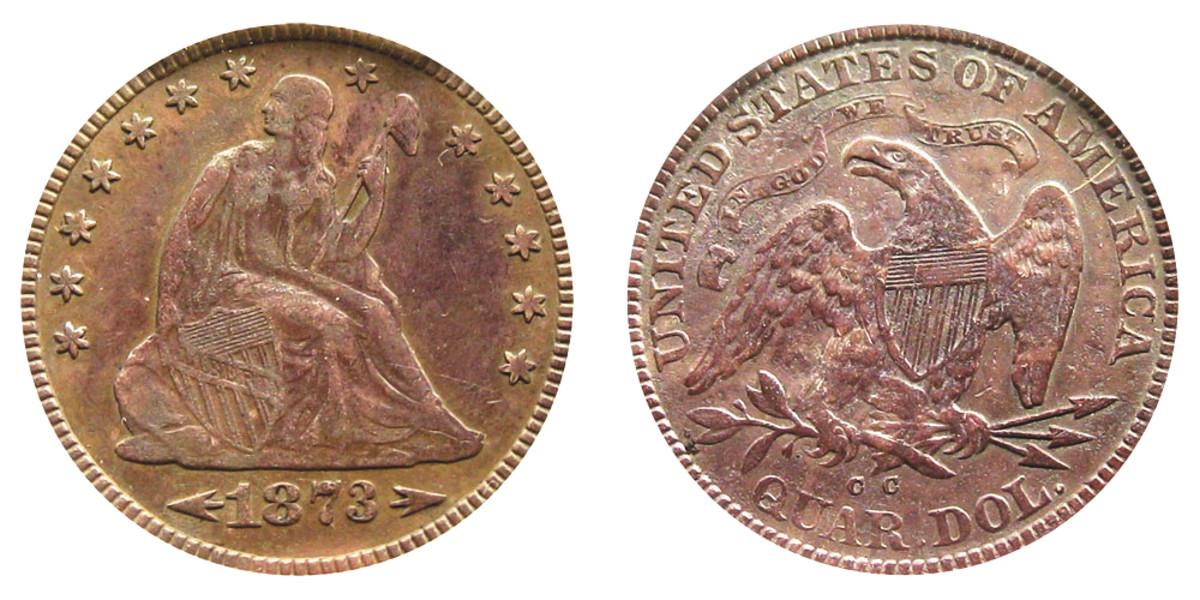1873-CC Seated Liberty Quarter – Numismatic News
One is a great rarity and the other is a lot tougher than many realize. This is the history of the two 1873-CC Seated Liberty Quarters.
The situation in 1873 was interesting. The price of silver started to fall. The immense wealth of the Comstock Vein made it virtually impossible to avoid. There just wasn’t enough demand for silver to avoid supply overflowing demand and leading to lower prices. In a truly remarkable move, the government decided to increase the silver content of silver coins. It wasn’t a big rise, the amount went from 0.1800 to 0.1808 ounces, but the fact remains that it was a rise.
Before the change was approved, Carson City had reported 4,000 quarters. It is likely that all but a few of the plant melted down as fewer than 10 examples of the No-Arrows 1873-CC are known today. So watch out for the Arrowless 1873-CC when it comes up for auction as it could make a surprise bid.
The slight increase in silver led to a design change for the remainder of the 1873 edition, in the form of arrows at the time. It wasn’t a law, but it had become a tradition that when the composition changed, the design had to change. When the silver was reduced in 1853, arrows and rays were added to the reverse for the date. The 1834 change in gold composition had seen entirely new designs. In 1873 they were content to simply add arrows.
Arrows would remain on that date for two years, but Carson City would only produce quarters in one of those two years: 1873. With part of the year already past, production of 1873-CC with Arrows was probably low, and it lay at 12,462 pieces.
The problem back in Carson City in 1873 was austerity. Even if you have a low mintage, if there are a number of dedicated collectors in the area, at least some harder-date specimens will be salvaged.
In 1873 there were virtually no people collecting coins in Carson City. There have been isolated instances of saves including the No-Arrows 1873-CC. After all, someone had to save these coins. Someone has also saved nickels from 1876-CC and later dates, but the fact remains that generally very little new issue has been saved in Carson City. And once they were circulated in Carson City, a typical round of circulation would leave every “CC” coin badly worn for a few years.
The simple fact is that the 1873-CC with arrows wasn’t melted down like the 1873-CC without arrows, but it might as well have been since it came into circulation and promptly disappeared.
Consider grading service totals. Only 12 examples are seen at the Numismatic Guaranty Company, one of which was called the AU-50. The next best were VF-20 examples. That speaks volumes. So does the Professional Coin Grading Service (PCGS) with a total of 18 seen copies. At PCGS they report a single MS-64, the next best is AU-55, but 11 of the 18 are no better than VF-20.
Normally, the 1873-CC’s G-4 price with arrows would look good at $4,600, as would the MS-60’s $85,000 listing. In this case, however, the prices look reasonable, if not low. Of particular note is that the two services saw only 30 coins combined. There are rare Dahlonega Mint gold coins with a mintage of around 1,000 that have been seen 100 times. However, this is a quarter that is usually seen more as gold, and with a circulation of nearly 12,500. However, the total of 30 coins could well contain repetitions.
Obviously the 1873-CC with arrows is a very difficult datum and one to grab if you get a chance. If you happen to find one better than VF-20 then you should acquire the coin if you can afford it as even in higher mintage the 1873-CC with arrows is a great rarity.


Comments are closed.